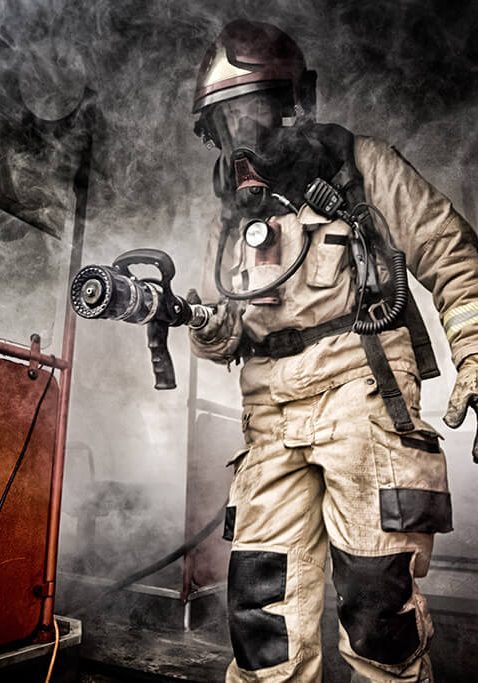
LCO2 washing process as a method for complying with the legally regulated measures for protecting firefighters from hazardous substances

The legal framework
The legal framework within which the fire department operates is diverse. The main addressee is the respective fire department provider, as defined in the state fire laws. The obligations thus affect the municipalities that maintain professional fire departments and volunteer fire departments, as well as the operators of company fire departments. Regardless of the legal framework applicable to a particular fire department, the protection of firefighters is always paramount and must be comprehensively ensured. Violations of the statutory duties to protect by the fire departments' sponsors can have serious consequences.
I. Occupational Safety and Health Act
The Occupational Health and Safety Act applies to members of professional and plant fire departments and comprehensively obliges fire department operators to prevent work-related accidents and health hazards. As a basic obligation, the Occupational Health and Safety Act stipulates in § 3 para. 1 that the necessary measures are to be taken for the safety and health of the employees. The effectiveness of the measures must be constantly monitored and improved.
II. Ordinance on Hazardous Substances
The obligations of the Ordinance on Hazardous Substances (GefStoffV) apply to all activities in which employees may be exposed to hazards to their health from substances, mixtures or products. Due to its wide scope of application, it applies to professional fire departments, volunteer fire departments, compulsory fire departments and company fire departments. The GefStoffV defines the specific measures to be taken if they handle hazardous substances or are exposed to them in the occupational environment. Protective measures must be state of the art to ensure effective protection of firefighters.
III. Accident prevention regulations
In addition, the accident prevention regulations, in particular DGUV Regulation 49 "Fire Departments", apply by law to volunteer fire departments and compulsory fire departments. It makes it unambiguously clear in § 3 and § 15 that the fire department operator is responsible for the protection of the fire department members.
IV. Technical rules
Technical rules such as the Technical Rules for Hazardous Substances (TRGS) must also be observed. They specify the legal requirements of the GefStoffV and reflect the state of the art for certain sub-areas. TRGS 500 "Protective measures" describes, for example, the protective measures for activities involving hazardous substances.

Duties towards firefighters
I. The minimization requirement under hazardous substances law
One of the core obligations of occupational health and safety, which must be observed by every fire department operator, is the duty set out in Section 7, Para. 4 GefStoffV stipulates the minimization requirement:
"The employer shall exclude hazards to the health and safety of employees during activities involving hazardous substances. If this is not possible, he shall reduce them to a minimum."
The fire department's sponsor is obligated to comprehensively protect firefighters from danger. If he cannot rule out a hazard – such as in firefighting – he must reduce the hazard to a minimum. Minimum is what is possible according to the state of the art. The more serious the danger – such as cancer – the more far-reaching the measures to be taken.
II. Far-reaching obligations for activities with carcinogenic substances
The fire department is subject to strict regulations for activities in which employees are exposed to carcinogenic substances. He or she must fully inform and educate fire department personnel about the hazard and the countermeasures taken, among other things. In addition, he must keep an exposure record and retain it for a period of 40 years if employees are exposed to PAHs while performing their jobs.


The protective equipment


I. The PPE as a source of danger
Hazardous substances are released during fire incidents. Most recently, the study conducted by the Heyrothsberge Institute for Fire and Disaster Protection for the Standing Conference of the Ministers and Senators of the Interior of the Federal States proved that PAHs are also involved. PAHs have been shown to have a high carcinogenic effect and are also skin resorptive. The relevant EU Regulation 1272/2008 and EU Directive 2004/37/EC on the protection of workers from the risks related to exposure to carcinogens or mutagens at work therefore classify PAHs as carcinogens. Contamination with PAHs must therefore be avoided. The TRGS 551 emphasizes in this respect that even in the case of "small-area and short-term skin contact with PAHs (...) poses a high risk of cancer through skin contact".
State-of-the-art PPE, properly used, reduces the risks to firefighters in the field. However, it becomes massively contaminated when used during a fire incident and thus becomes a source of danger itself. Recent studies confirm that significant concentrations of PAHs are detectable in the face fabrics as well as the membranes of PPE after use. Through contact of the PPE with the skin, PAHs can be absorbed by the body to a considerable extent when the PPE is used again.
Protection from hazards emanating from the PPE through LCO2 cleaning.
The fire department wearer must ensure that even contaminated PPE does not pose a hazard to fire department personnel. He fulfills his basic obligation only if the PPE provided is also properly cleaned and no additional danger arises from its use. Contamination in the use of contaminated PPE must be reduced to the minimum possible. The Heyrothsberge Institute for Fire and Disaster Protection confirmed that a pure wet wash, even if performed according to the Robert Koch Institute's disinfection specifications, removes PAHs only to a very limited extent. In contrast, studies from the USA and evaluations from Germany and Belgium show that LCO2 cleaning effectively removes PAHs. LCO2 cleaning as an extractive process therefore represents the state of the art. According to the minimization requirement, the fire department carriers must therefore ensure such cleaning of the PPE. At the same time, this process does not adversely affect the special reflective properties of the protective clothing, which must be present according to DIN EN 469:2007 or DGUV Rule 105-003, as is the case with wet washing.
III. Comprehensive duty to provide information
Because of the high carcinogenic effect of PAHs, firefighters must be fully educated about the hazards and protective measures. This applies in particular to hazards that may emanate from the PPE. The fire department provider must inform firefighters of the hazards posed by contaminated PPE, what measures (e.g., cleaning, repair) it has taken to protect them, and how these minimize a hazard according to the state of the art. This includes information about residual contamination remaining after wet cleaning and the hazards associated with it. In this way, every firefighter must be able to see that or if the most effective actions have been taken and the fire department's sponsor is in compliance with the law.

Responsibility of the fire department carrier
Violations of occupational health and safety regulations can be punished as administrative offenses. Within the scope of application of the GefStoffV, a fine of up to EUR 50,000 may be imposed. It is sufficient if the duties were violated negligently, i.e. if the danger could have been recognized with due diligence.
In addition, such violations of the law may also give rise to criminal offenses. If the necessary protective measures have not been taken and this leads to illness or even death, this can result in criminal liability under the Criminal Code for negligent bodily injury (Section 229 of the Criminal Code) or negligent homicide (Section 222 of the Criminal Code). The occupational health and safety regulations also contain specific penalty provisions. The range of punishment is up to five years imprisonment.


Conclusion

In summary, firefighting agencies are required, both for the protection of firefighters and to avoid liability risks, to permanently provide PPE that is maintained in accordance with the state of the art and from which no health hazards emanate. This requires, in particular, effective purification of carcinogenic substances such as PAHs. The process must correspond to the state of the art.
With LCO2 cleaning, this is ensured.

DOWNLOAD
LOCATION NRW
7YRDS Deconservice GmbH
Von-Monschaw-Straße 12a
47574 Goch, Germany
T + 49 441 361 9943 - 1
E eckhardt@7yrds.com
LOCATION NIEDERSACHSEN
Textilreinigung ECKHARDT GmbH
Bloherfelder Straße 229
26129 Oldenburg, Germany
T + 49 441 361 9943 - 1
E eckhardt@7yrds.com
FOLLOW US
© 2026 7YRDS Deconservice and Textilreinigung ECKHARDT GmbH | Companies of the 7YRDS Group | All rights reserved


